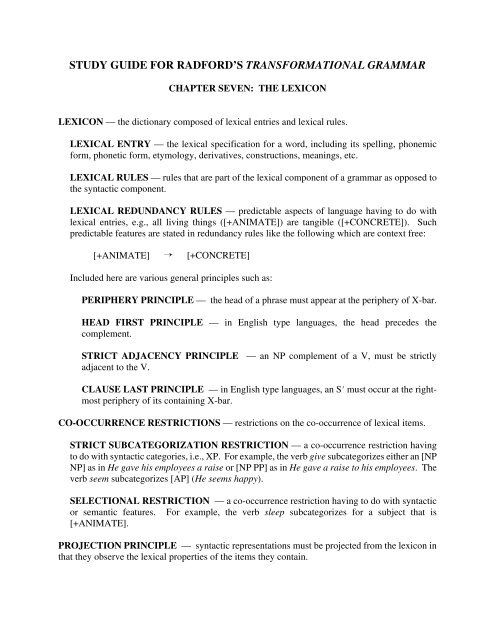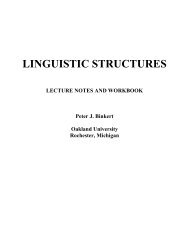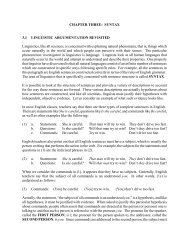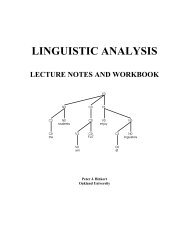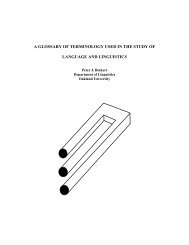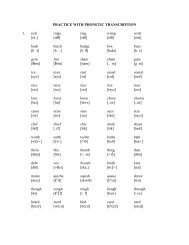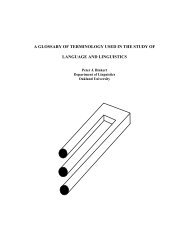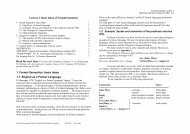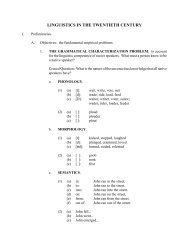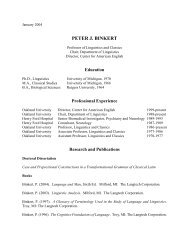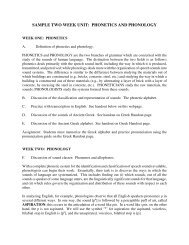STUDY GUIDE FOR RADFORD'S TRANSFORMATIONAL GRAMMAR
STUDY GUIDE FOR RADFORD'S TRANSFORMATIONAL GRAMMAR
STUDY GUIDE FOR RADFORD'S TRANSFORMATIONAL GRAMMAR
You also want an ePaper? Increase the reach of your titles
YUMPU automatically turns print PDFs into web optimized ePapers that Google loves.
<strong>STUDY</strong> <strong>GUIDE</strong> <strong>FOR</strong> RAD<strong>FOR</strong>D’S TRANS<strong>FOR</strong>MATIONAL <strong>GRAMMAR</strong><br />
CHAPTER SEVEN: THE LEXICON<br />
LEXICON — the dictionary composed of lexical entries and lexical rules.<br />
LEXICAL ENTRY — the lexical specification for a word, including its spelling, phonemic<br />
form, phonetic form, etymology, derivatives, constructions, meanings, etc.<br />
LEXICAL RULES — rules that are part of the lexical component of a grammar as opposed to<br />
the syntactic component.<br />
LEXICAL REDUNDANCY RULES — predictable aspects of language having to do with<br />
lexical entries, e.g., all living things ([+ANIMATE]) are tangible ([+CONCRETE]). Such<br />
predictable features are stated in redundancy rules like the following which are context free:<br />
[+ANIMATE] [+CONCRETE]<br />
Included here are various general principles such as:<br />
PERIPHERY PRINCIPLE — the head of a phrase must appear at the periphery of X-bar.<br />
HEAD FIRST PRINCIPLE — in English type languages, the head precedes the<br />
complement.<br />
STRICT ADJACENCY PRINCIPLE — an NP complement of a V, must be strictly<br />
adjacent to the V.<br />
CLAUSE LAST PRINCIPLE — in English type languages, an S must occur at the rightmost<br />
periphery of its containing X-bar.<br />
CO-OCCURRENCE RESTRICTIONS — restrictions on the co-occurrence of lexical items.<br />
STRICT SUBCATEGORIZATION RESTRICTION — a co-occurrence restriction having<br />
to do with syntactic categories, i.e., XP. For example, the verb give subcategorizes either an [NP<br />
NP] as in He gave his employees a raise or [NP PP] as in He gave a raise to his employees. The<br />
verb seem subcategorizes [AP] (He seems happy).<br />
SELECTIONAL RESTRICTION — a co-occurrence restriction having to do with syntactic<br />
or semantic features. For example, the verb sleep subcategorizes for a subject that is<br />
[+ANIMATE].<br />
PROJECTION PRINCIPLE — syntactic representations must be projected from the lexicon in<br />
that they observe the lexical properties of the items they contain.
THEMATIC RELATION ( -ROLE) — a term that specifies the various roles that a noun phrase<br />
can play in a clause, e.g., agent, experiencer, source, goal, etc. (Not to be confused with syntactic<br />
relations like subject and direct object).<br />
(1) THEME (PATIENT): the entity undergoing the effect of the action identified in the verb.<br />
a. Someone opened THE DOOR. (door is both direct object and theme.)<br />
b. THE DOOR opened. (door is subject, but still theme.)<br />
(2) AGENT (ACTOR): the instigator of the action identified in the verb.<br />
a. JOHN opened the door.<br />
b. The door was opened BY JOHN.<br />
(3) EXPERIENCER (DATIVE): the entity experiencing some psychological state identified<br />
in the verb.<br />
a. The movie appeals to HIM.<br />
b. SHE is happy..<br />
(4) INSTRUMENT: the means by which the action identified in the verb comes about.<br />
a. He broke the window WITH THE HAMMER.<br />
b. THE HURRICANE destroyed the village.<br />
(5) BENEFACTIVE: the entity benefitting from the action identified in the verb<br />
a. He bought the flowers <strong>FOR</strong> MARY.<br />
b. He bought MARY the flowers.<br />
(6) LOCATIVE: the plsce which identifies the location or spatial orientation of the state or<br />
action identified in the verb.<br />
a. It happened IN ITALY.<br />
b. The book is ON THE TABLE.<br />
(7) GOAL: the place which identifies the direction of the state or action identified in the verb.<br />
a. John flew TO ITALY.<br />
b. John ran INTO THE HOUSE.<br />
(8) SOURCE: the place which identifies the origin of the state or action identified in the verb.<br />
a. John flew FROM ITALY.<br />
b. John ran OUT OF THE HOUSE.<br />
-CRITERION — Each argument bears one and only one -rule, and each -role is assigned to<br />
one and only one argument.<br />
ARGUMENT — An NP that functions as a subject or a complement. Subjects are external<br />
arguments; complements are internal arguments.<br />
2
LEXICAL IN<strong>FOR</strong>MATION<br />
(9) The lexicon lists specialized properties of lexical items. Lexical entries should only contain<br />
information which is not predictable.<br />
a. go is irregular [past tense is went]<br />
b. go is intransitive [*He went the library]<br />
c. put requires both a direct object and a PP complement<br />
(10) The lexicon also lists generalized properties of lexical items - properties that can be predicted<br />
across a group of lexical items of a particular type. Redundancy rules.<br />
a. The past tense of verbs is {-d}.<br />
b. Subjects and Direct Objects are NP: REALIZATION RULE.<br />
c. Direct Objects must immediately follow verbs: STRICT ADJACENCY PRINCIPLE<br />
and so on<br />
(11) give [+V, –N]; [Actor, Theme, Goal]<br />
General principles predict:<br />
EXAMPLE<br />
a. The Actor argument is the subject. It is an NP with an animate noun in the head.<br />
b. The Theme argument is the direct object. It is an NP.<br />
c. The Goal argument is the indirect object which is a PP introduced by the P to.<br />
The Goal is not a place, but most likely a person.<br />
d. The verb allows “Indirect Object Inversion”:<br />
V + NP 1 + [ PP to NP 2] V + NP 2 + NP 1<br />
[I gave the book to him I gave him the book]<br />
3
CONSIDERATIONS IN SEMANTIC ANALYSIS<br />
Semantic analysis involves using information specified in the lexicon to determine the meaning of<br />
phrases and sentences. Consider the following:<br />
(12) a. He got the family into the shelter.<br />
b. He got the family into debt.<br />
The two sentences above appear to involve parallel thematic representations; close examination,<br />
however, reveals that they are not parallel. First, into the shelter must be a positional theme (one<br />
referring to spatial relations), whereas into debt must be non-positional. Notice that we have He<br />
managed to get his family there into the shelter before the tornado struck, but not *He managed to<br />
get his family there into debt after a week–long gambling binge.<br />
Second, while He got the family into the shelter entails that the family is in the shelter and He got<br />
the family into debt entails that the family is in debt, the analyses of the two sentences must be<br />
different. In the former, the shelter possesses the family (The shelter contains the family); in the<br />
latter, the family possesses the debt (The family has debt). While one can paraphrase He got the<br />
family into shelter (without the definite article before shelter) as He gave the family shelter, one<br />
cannot paraphrase He got the family into the shelter (with the definite article) as He gave the family<br />
the shelter. The two sentences have very different interpretations. Further, if we change the shelter<br />
to some other container like a car, similar paraphrases are also impossible: He got the family into<br />
the car does not mean that He gave the family the car.<br />
Third, the selectional restrictions between the phrases in (12a) and those in (12b) are very different.<br />
To illustrate this, let us refer to the phrase that contains family as the “entity,” the one containing<br />
shelter as the “location,” and the one containing debt as the “condition.”<br />
In (12a), the entity and the location are constrained by such considerations as number and size. For<br />
example, He got/put all fifty members of his family into the car seems farfetched, whereas He got/put<br />
all fifty members of his family into the bus does not. Notice that no such constraint exists in a<br />
sentence like He got/put all fifty members of his family into debt or He got/put the entire population<br />
of the city into danger. This distinction derives from the fact that phrases like into the shelter and<br />
into the car are positional whereas phrases like into debt and into danger are non-positional.<br />
The constraint between the entity and the condition in (12b) is entirely different. Basically, the<br />
entity must be able to experience the condition. Thus, He got the family into debt and He got the<br />
family into danger are possible because families can experience debt and danger. On the other hand,<br />
He got the snake into debt and He got the pencil into danger make very little sense, if any. This<br />
distinction derives from the fact that phrases like into debt and into danger are non-positional.<br />
4


